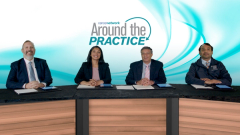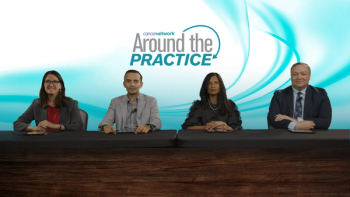
Key Trial Data Guiding Treatment Decisions for Patients with NDMM
Thoughtful discussion centered around recently presented updates to the GRIFFIN, MASTER, and GMMG-CONCEPT studies in NDMM patients.
Episodes in this series

Dr. Sagar Lonial: We've talked a lot about Dara-RVd, and I think the GRIFFIN study certainly was one study to get us going there. There are other studies that I think are important, Dr. Nooka, that you want to touch on, that either take CD38 or take a different PI into the mix. And what do we know about those studies?
Dr. Ajay Nooka: So, there are two studies in this space that have clearly shown the benefit, are risk stratified, in a minute, to talk about which groups are the ones that got benefited the most. So, as a general approach, as a general rule, we use Dara plus RVd as a quadruple in most patients. There is a small group of patients who fall under this category of the high-risk disease who don't get the same benefit as a standard-risk patients. So, the question comes in here, is should we do something differently for them, should we add more? So, in that context, there is a trial that was done in 123 patients - so, this was a master trial - using daratumumab, carfilzomib, lenalidomide, and dexamethasone. And I may not agree with the design of the trial, but what could be inferred from the trial is 80% of the patient's, post induction, achieved an MRD negative at 10 to the power of minus five. These are good results. Can we extrapolate these results to our clinical practice and use these results to guide our therapy for those patients that may not get the same kind of a benefit as everybody else? So, in the same context- So, to add this, the GMMG-Concept trial has really looked at the high-risk patients by definition using only deletion 17p translocation 4;14 and 14;16. And what they did was use this CD38 monoclonal antibody, isatuximab, in combination with the same backbone of KRd. And with this regimen, their endpoint- So, their endpoint was MRD negativity as consolidation. The trial design is very unique in the sense, everybody gets six cycles of Isa plus KRd, and transplant-eligible patients would get a transplant followed by four [INAUDIBLE] cycles of Isa-KRd-S consolidation. The transplant ineligible patients will get Isa-KRd for two additional cycles in place of a transplant. So, at the end of the consolidation, they were asking for an MRD negativity rate beyond that 50%, which was an another that they considered, and to be considered a successful induction regimen, the MRD negativity rate at 10 to the power of minus five should be beyond that 60% rate, and here they were able to show that you can achieve with this combination in transplant-eligible patients and in ineligible patients in close to 70% of the patients. So, good results supporting what we do, using a data combination with KRd. We're only talking about the induction that we could achieve that MRD negativity rates.
Dr. Sagar Lonial: So, if you're trying to make some recommendations for people out in the community in terms of what to do, do we use high risk or standard risk to drive therapy? How are you guys thinking through that? Because, I think, you've all presented really interesting data, we're going to hear another data set from Dr. Joseph in just a moment, but how do you synthesize this into a coherent, easy way for people to make decisions?
Dr. Ajay Nooka: So, I would always talk about the framework. The framework of you take three boxes of treatment. Box number one is the induction, box number two is a transplant, box number three is the maintenance. Those boxes can change based on the risk stratification. Once you identify the patient, who that person is, the standard-risk courses versus the high risk, the goal should be achieving the deepest response possible. So, Dara really, for the standard-risk patients, and Dara-KRd, probably, for the high-risk patients. You're achieving a goal at the end of induction. Then if the patient is transplant eligible, absolutely, you fill in that box of transplant. When you come to the third box, that is where, if it's a standard-risk patient, even though we have data coming from the ATLAS study, from the Forte trial, that two drugs are better than one, but in reality, we don't need those drugs because it means extra cost, extra resources, extra side effect profile for the patients. We can make a case if the patient really needs it, and that's the case I would make for a high-risk patient where they would need more than one drug.
Dr. Sagar Lonial: Do you want to add to that?
Dr. Jonathan L. Kaufman: Yeah, I agree completely. I think, conceptually, we know, the way I think about induction therapy for standard risk, we see, just like we've seen over and over again, the better therapies you have benefit the standard-risk patients the most. So, Dara-RVd for standard risk. And for high risk, I think the concept is, is we should use whatever regimen we think is best. And so, I think there's a lot of debate in what high risk is, but I think the principle in high risk, as you said, is use your best induction regimen. These are patients where there should be very little debate that autologous transplant is superior than not autologous transplant. And thirdly, we should move away from the debate that two-drug or three-drug maintenance therapy is better than one-drug maintenance therapy, for high-risk patients. And so, I think that's our approach, and we have, what, more than a decade of treating patients with doublet and triplet in a high-risk setting. Originally we did RVd, we moved to KRd. Dr. Nooka's going to present shortly a very beautiful study of KPD as maintenance in high-risk patients. So, I think that's the key element, is to not undertreat high-risk patients, because if you undertreat high-risk patients, they'll certainly relapse early, and that's associated with the bad overall outcome.
Dr. Sagar Lonial: When you think about the boxes, that's a nice, simple framework for us all to think about, and I sort of think about in high risk, the most important thing is not losing a response in box one and maintaining the response in box three, because that's where you often lose. If you undertreat in box one, you may have a response, and then you lose a response, if you don't treat intensively enough in box three, you may lose the response that you've already gotten. So, I think it is a nice balance. So, Dr. Joseph, you're going to tell us about an antibody that I remember almost five years ago presenting at ASCO in a phase-3 trial that has sort of fallen down in the last few years. Tell us where it is.
Dr. Nisha Joseph: So, you're talking about elotuzumab, and so, I think, in the veins of talking about quadruples and looking at monoclonal antibodies, but in contrast, instead of looking at daratumumab and isatuximab, which are anti-CD38 antibodies, elotuzumab targets a different antigen, target SLAMF7, which has NK-cell activating properties. And so, basically, this trial is looking at elotuzumab in combination with KRd and transplant-eligible newly diagnosed patients. So, the trial is designed with six cycles. Patients are randomized, either Elo-KRd versus KRd, followed by transplant with an option for a tandem, transplant for patients who don't achieve at least a complete response to the initial maneuver or have high-risk disease, and then followed by additional consolidation, and then maintenance with either Elo-Len or Len to progression. And the primary endpoint of the study was looking at MRD negativity and patients who had at least achieved a VGPR. And so, what has been presented is the VGPR rates- The MRD rates, excuse me, initially, are about 50% in the quad arm versus 35% in the triplet arm. Which I think, again, to me, is showing that quadruples can be better in terms of depth of response. We can achieve deeper control of the disease and potentially longer PFS1. I think, when you compare that to the MRD negativity rates that we're seeing with daratumumab and KRd, which Dr. Nooka just presented, so, the MASTER trial over 80% and 60% in the concept, and IFM studies, probably not lining up or matching up with what we're seeing with anti-CD38, but I think, overall, making the case for a quadruplet over a triplet and newly-diagnosed myeloma.
Newsletter
Stay up to date on recent advances in the multidisciplinary approach to cancer.
















































































